#Detective Comics 27
Explore tagged Tumblr posts
Text






DC Multiverse DC Direct Batman Detective Comics #27 (1st Appearance) Cowl Replica - McFarlane Toys
Link para compra BR: *Possível importar pelo Link abaixo
Buy here: https://amzn.to/3Pfb6A6
#dc#comics#McFarlane#action figure#dc multiverse#dc direct#Replica#Cowl#Cowl Replica#statue#batman#detective comics#batman first appearance#Detective Comics 27#bruce wayne#first appearance
10 notes
·
View notes
Text
Detective Comics #27
Where it all began
Cover:
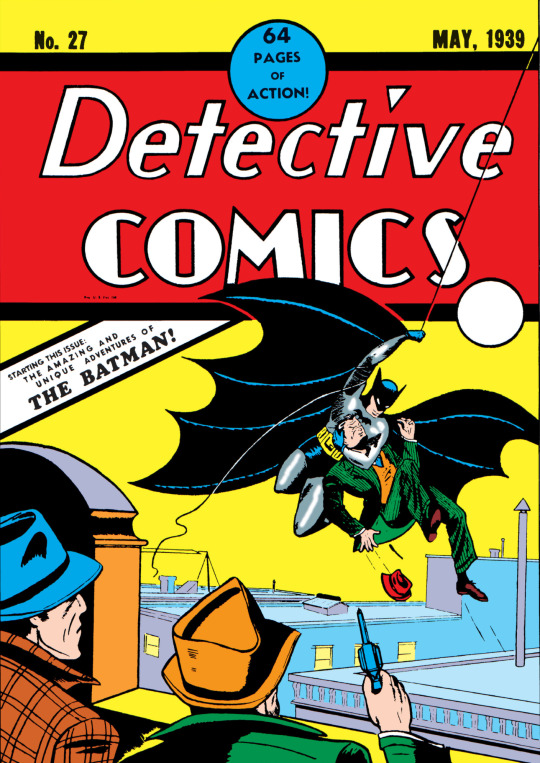
This is a great cover to start things out! It's iconic!! I always love seeing the redraws of this!
I got this screenshot of the cover from the Batman: The Golden Age Vol. 1 which you can tell from the fact that the words "THE BATMAN!" on the cover are black and not red like the original cover from 1939. For the rest of this post I will be using screenshots from an old digitization of the comic except for a few which I got from The Golden Age Vol 1. which I use at the end. Even though it says "64 pages of action" on the cover, The "Bat-Man" story is only 9 pages long and I will only be focusing on that. (Sorry Slam Bradley fans!) Now to get into the issue.

It starts off with this title page where they introduce the "Bat-Man" to the reader. It's very nice!
It's very strange to see him labeled at the "Bat-Man". I'm just not used to it but anyways they drop it fully Detective Comics #30. (Also note that I read it like "Bat Dash Man")
It's also very sad to see The Batman only credited to Bob Kane. Bill Finger did mostly everything and didn't get recognition for it until 2015.
Anyway, Back to the comic-
Bruce Wayne and Commissioner Gordon are chilling out at Gordon's place when suddenly Gordon gets a call about a recent murder. They need him there right away and in the most laid-back way, he's like, "Hey, Bruce, buddy, pal, chum, they need me at a murder scene... Wanna come with?"
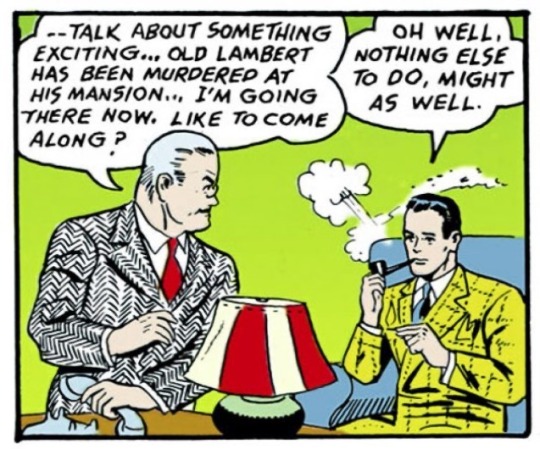
and Bruce is deadass like "Eh sure. Why not"
Everything was so casual in the 30s god damn.
Anyway, They rush over to the scene of the crime
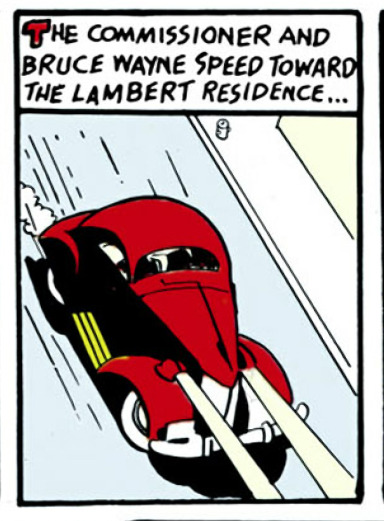
and after "a thorough examination of the scene of the crime" they decide to talk to the victims son, who is the current murder suspect.
He's like, "I didn't do it, I only grabbed the knife when I pulled it out of my dad's chest!" And, weirdly, Gordon doesn't press any further on it. He's just like "Yep okay."
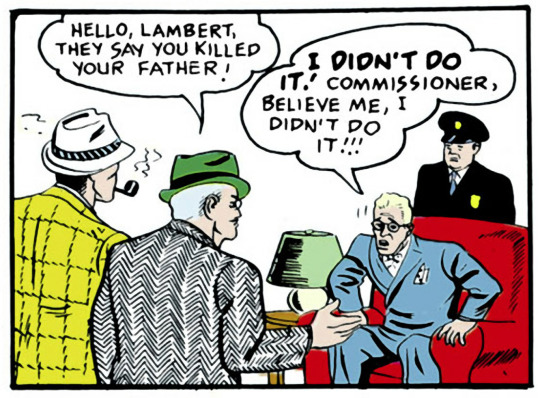
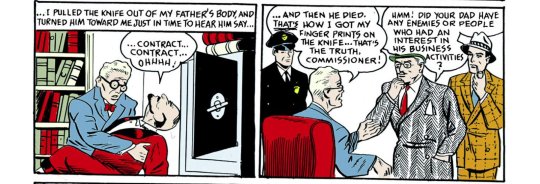
Also, he could've stayed alive if you didn't pull the knife out dummy. But I digress
He then responds to Gordon's question like "Dunno, Except these 3 guys"
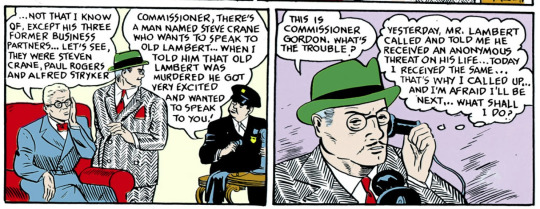
Also the comedic timing of that- I made a joke to my friend when I first read this comic that the reason why Steve Crane was excited was because he bet Lambert a hundred bucks in 1939 dollars that the threat on his life was real- I know excited back then meant having excessive emotions but I just thought it was funny.
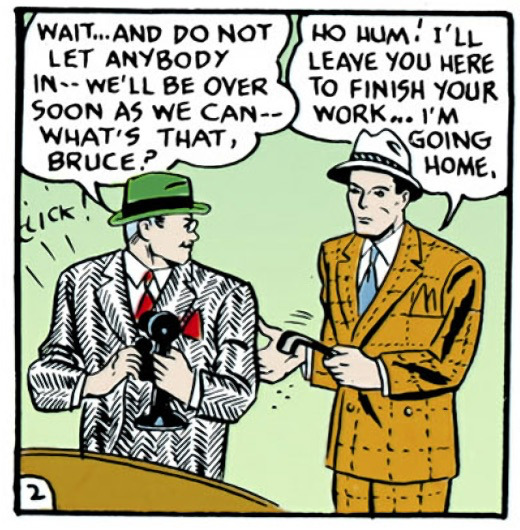
You sus mf. I SEE you Bruce. If that even is your real name.
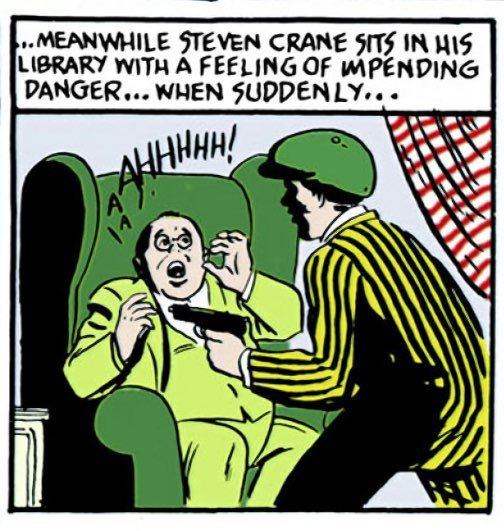
I also love this panel.
After Crane gets shot the murderer/robber escapes with a piece of paper.
When Suddenly...
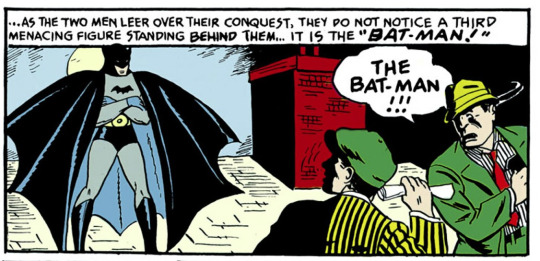
The Bat-Man shows up and beats the hell out of them and takes the paper. Then Gordon and the police arrive to Steven Crane's house as the Bat-Man runs away. Gordon then finds out Crane has been killed and decides to go to Paul Rogers house
Also look at my little man
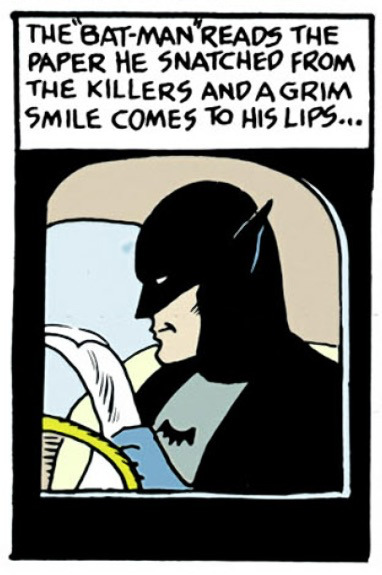
He's so proud of himself.

I also love the fact that he drives off in Bruce Wayne's car from earlier in the issue. He's so silly
Meanwhile, Rogers goes to his friend's, Alfred Stryker's, neighboring Laboratory where he encounters Strykers assistant, Jennings, and gets smacked and trapped by him.
I thought this panel was hilarious.
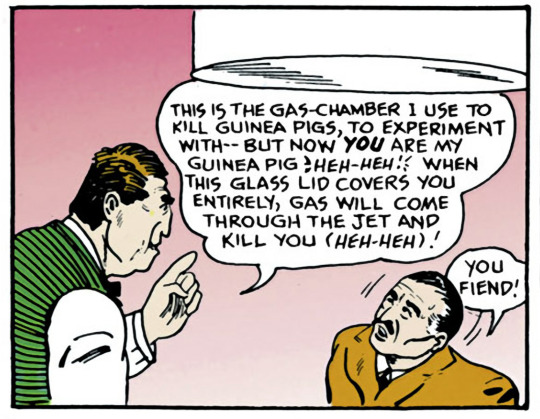
Like Boi! What kind of guinea pigs are you experimenting with that you need to a jar that can fit a human inside and also why are you gassing guinea pigs???
He then seals the chamber but not before the "Bat-Man" enters, plugs the gas-jet and breaks Rogers out.
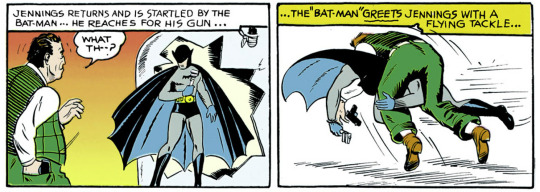
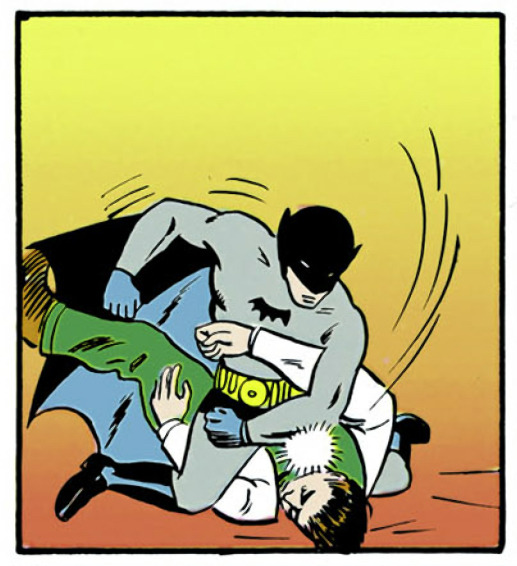
Speaks for itself really. Styker then finds out his assistant failed at killing Rogers and tries to kill him himself but the Bat-Man, who had hidden, jumps out and prevents the Stryker from killing Roger. The Bat-Man explains why Stryker like Velma at the end of an episode and then Stryker breaks out of The Bat-Mans hold and then
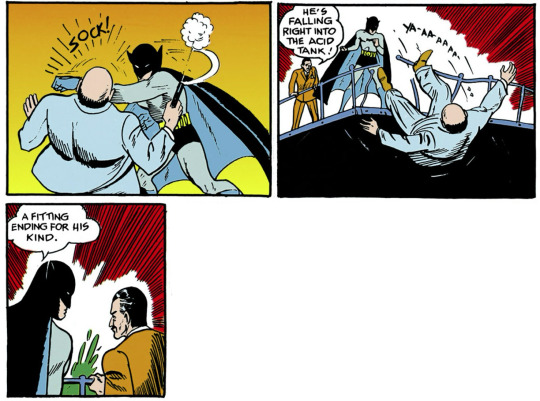
The Bat-Man straight up kills him and is like "Good."

Bro is so sus. No one acts this way. And then what's more is that Gordon is like "Man. bro is so bored all the time."

Look at my silly dressing up in his bat fursuit!!

Can't wait for next month!! ------------------------------------------------------------------------------ Sorry I basically recapped the whole story. It was very short but every panel had something interesting happening!! I definitely recommend it!!
Things I liked and found interesting!!
I found it interesting how they have text explaining the situation instead of just letting the photos do the talking.


Thought It's probably like that because they only had 9 pages to tell the story.
I liked Commissioner Gordon's fit in this issue.
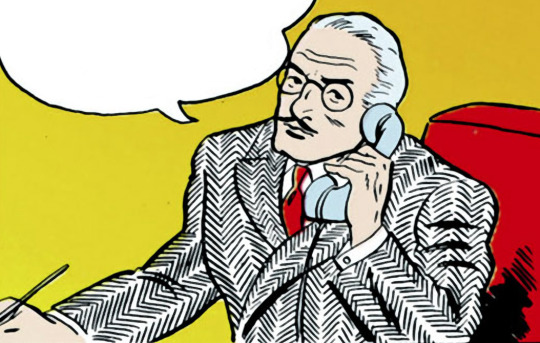
It's a very nice Zebra-like suit that would allow him to fit in with the the weirdo 248 issues from now. It's just so snazzy!
I also like how Gordon takes things at face value and doesn't do some deeper thinking like how I'd assume a police commissioner would. "Well obviously he didn't kill his father. He literally just said he didn't". "I just told Bruce something amazing and he looks like he had heard it before. He must lead a boring life"
I also love The Bat-Man costume in this issue
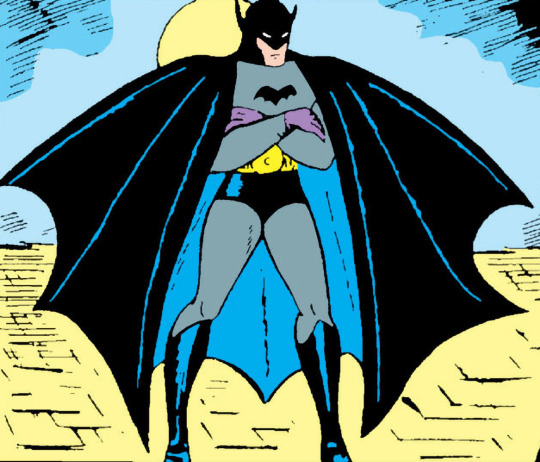
Purple glove Batman... My beloved <3
The art in this issue is great too!! I'll pick out a few of my favourite panels to show.
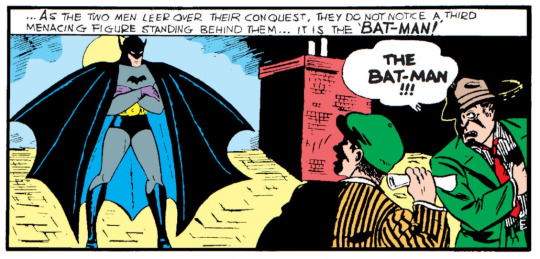

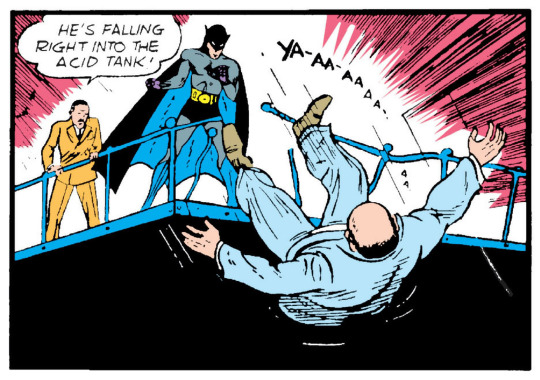
Thank you all for reading my first blog post!!
Come back whenever! Rarely the same Bat-Time but always the same Bat-Blog
4 notes
·
View notes
Text
Batman: 85 anni di giustizia e oscurità
Cari lettori di Batman Crime Solver, è un momento straordinario per noi fan di Batman, poiché celebriamo l’ottantacinquesimo anniversario di vita del Cavaliere Oscuro. Il nostro eroe iconico, creato da Bob Kane e Bill Finger, ha segnato la storia dei fumetti, del cinema, della radio e dei videogiochi come pochi altri personaggi. Continue reading Batman: 85 anni di giustizia e oscurità
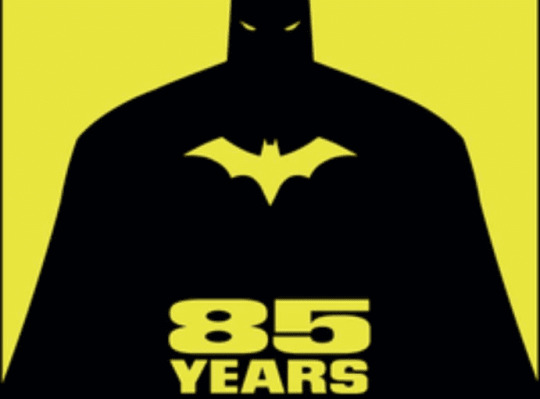
View On WordPress
#Amstrad CPC#Batman#Bill Finger#bob kane#cavaliere oscuro#dc comics#detective comics#Detective Comics 27#heath ledger#joker#Lewis Wilson#Matt Reeves#MSX#SPOTIFY#The Audio Adventures#The Batman#Tim Burton#videogame#videogiochi#warner bros#ZX Spectrum
2 notes
·
View notes
Text




detective comics #27: the case of the chemical syndicate
distracted & bored young socialite chap, bruce wayne, entertained by his older gentleman friend, commissioner gordon
#bruce wayne is the mask right from the very beginning baby#bruce wayne#james gordon#detective comics 27#batman#golden age batman
6 notes
·
View notes
Text
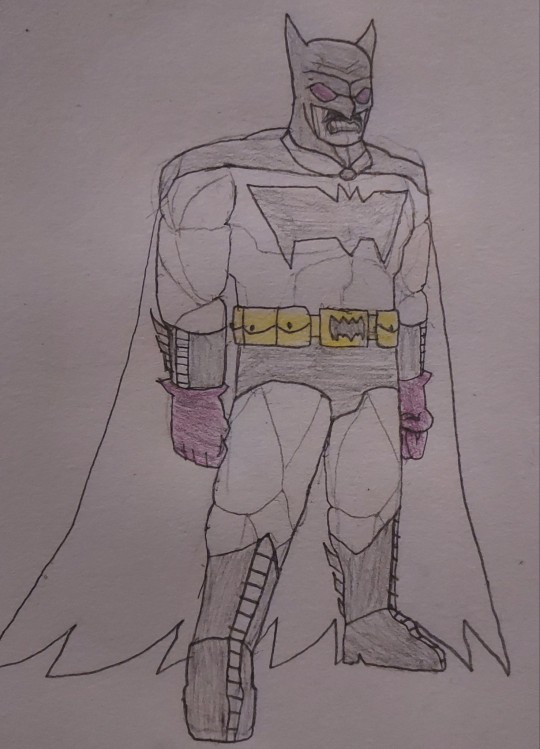
Happy batman day! Here's a drawing I did of an old batman design from 2021
#dc comics#batman#dc#art#my art#detective comics#bruce wayne#the batman#detective comics 27#batman day#happy batman day
2 notes
·
View notes
Text
McFarlane Toys - DC Direct Batman Detective Comics #27 (1st Appearance) 1:10 Scale Resin Statue
Batman has dedicated his life to an endless crusade, a war on all criminals in the name of his parents, who were taken from him when he was just a child. Since that tragic night, he has trained his body and mind to near physical perfection to be a self-made super hero. He’s developed an arsenal of technology that would put most armies to shame. He is vengeance. He is the night. He is…

View On WordPress
1 note
·
View note
Text

DETECTIVE COMICS (1937) #27
#oh i'm sure#comics#dc#detective comics#detective comics (1937)#detective comcis (1937) 27#bruce wayne#jim gordon#photo#tais toi lys#lys reads comics#*panels
9 notes
·
View notes
Text

Brian Bolland: Batman
1977 British Comic Art Convention convention booklet
Source: Michael Lovitz (comicartfans)
Batman reading Detective 27 - 1977 Comic Convention illo, in Michael Lovitz's Covers Comic Art Gallery Room (comicartfans.com)
25 notes
·
View notes
Text
Gathering of the Greatest Gumshoes - Number 27
Welcome to A Gathering of the Greatest Gumshoes! During this month-long event, I’ll be counting my Top 31 Favorite Fictional Detectives, from movies, television, literature, video games, and more!
SLEUTH-OF-THE-DAY’S QUOTE: “The world will look up and shout, ‘Save us!’ And I’ll whisper, ‘No.’”
Number 27 is…Rorschach, from Watchmen.
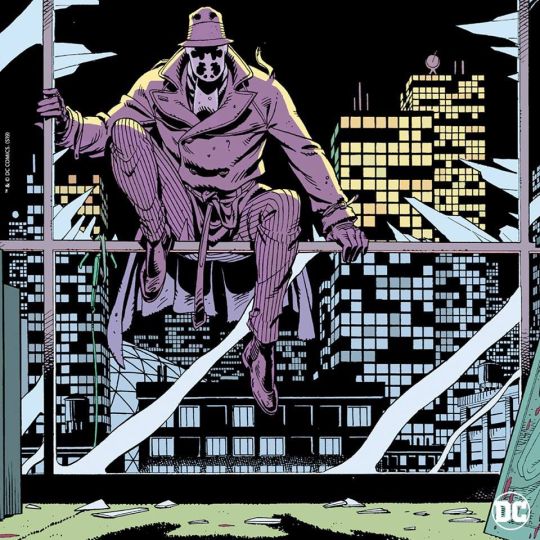
A lot of you are probably surprised to see a character as iconic as Rorschach – arguably the most famous character from one of the greatest graphic novels of all time, “The Watchmen” – so low in the ranks. Well, trust me, as iconic as Rorschach is, there’s a good reason I place him where I do, but we’ll get to that in a bit. For now, let’s focus on the character himself.
Unless you’ve been living under a rock nowhere near a book-and/or-magazine-vendor since the mid-80s, then the chances are good you’ve at least heard of “The Watchmen.” This was the arguable masterpiece of English comic book writer Alan Moore. This man is something of a strange legend in the world of comics, responsible for such titles as “The League of Extraordinary Gentlemen,” “V for Vendetta,” and “From Hell,” as well as being the author of “Batman: The Killing Joke.” However, many agree that when you hear his name, “Watchmen” is the first of his works that seems to come to mind. This graphic novel was a hyper-dark deconstruction of the superhero genre as a whole, and set the groundwork for a lot of comic book stories that would come after it. The idea of “superhero deconstruction” has sort of become a sub-genre within itself, to be honest, and while parody and satire of the genre did exist long before Moore whipped up this piece, “Watchmen” is almost universally agreed to be the place where the idea of taking superhero fiction and giving it a psychological and sociological bend, and showing that superpowered beings in the world aren’t necessarily the end of all problems, became REALLY popular.
The main protagonist of “Watchmen” (at least ostensibly) is Rorschach. Most of the characters in Moore’s book were based on pre-existing comic book characters, sort of blending original elements with older concepts to create recognizable figures and play off of established tropes. Rorschach is sort of a conglomeration of Batman, the Shadow, the Question, and a much lesser-known character called Mr. A. The story of the graphic novel focuses on Rorschach – real name Walter Kovacs – trying to solve the murder of his former superhero teammate, the Comedian. The adventure grows increasingly more bizarre (and thoroughly messed-up on MANY levels) as Rorschach uncovers a vast conspiracy and plots to commit mass slaughter, leading to many of the former Watchmen banding together again to try and figure out how to stop the chaos. Without going into too much detail, for those who don’t know already…yeah, it doesn’t exactly go how Rorschach – or, indeed, anybody – really planned. Rorschach is a fine sleuth, and the visual design of him – a noir-style detective’s getup combined with a bizarre, shifting inkblot mask – is certainly one of the most striking in all of comics, many would argue. However, what truly stands out about Rorschach is his philosophical viewpoint: Moore created Rorschach as a sort of satire on the strict objectivist policies many of the characters I mentioned earlier notoriously had. These were characters who seemed to see the world in a strictly black-and-white perspective, where good is good, bad is bad, and there’s basically no gray moral ground in-between. He does what he feels is right based on this ideal, but the problem is…that’s a REALLY hard ideal to put into practice in the real world without seeming like a complete idiot or semi-psychopathic. Rorschach’s steadfast nature, his determination to stick to his ideology, is both his greatest asset and his greatest failing: it’s an asset because it’s what allows him to get through as far as he does and keep focused on the case at hand. But it’s his greatest failing because his inability to cope with the gray area, and reason out anything beyond his basic, fundamental viewpoint, leads to a lot of personal problems, and ultimately to his own downfall. This is actually why Rorschach ranks as low as he does. To put things in the simplest terms possible: while I love the deconstruction and homages present in Watchmen, I feel like I prefer other takes on these concepts more, and I also prefer some of the characters that inspired Rorschach over the Watchmen's chief sleuth himself. Still, he's more than worthy of placement in the Top 31: when I think of comic book detectives, he's one of the first I imagine.
Tomorrow, the countdown continues with Number 26!
CLUE: “Truth brings closure.”
#list#countdown#best#favorites#top 31 fictional detectives#gathering of the greatest gumshoes#number 27#rorschach#watchmen#dc#comics#superheroes#mystery#alan moore
5 notes
·
View notes
Text
Ah God...years back I had hop-skipped a lot of Strong Girl Do Bong-soon from the halfway point and erased half the kidnapper plot from memory....
So the mystery part of Behind Your Touch is like, a jarring mashup of Bong-soon and Beyond Evil🙈 huh???


#behind your touch#kdrama#Only all parodies(comic) work...sigh...(nah I mean that is true: the comedy is one of the best; much much better than in Bong-soon or such)#That noir murder-thriller overkill...no no noooo#they were so fixated on red herrings they lost track of the context...down to 'just for fun' psycho! Seung-gil's death makes no sense??#coincidentally both Guk-doo and Ju-won were 27(26) in-series (them all being kid-ish I get); even so both did significant detective work#it's confusing if Moon is a Dirty Harry or they were seriously trying to critique police procedural dramas the entire way...#the 'comical' knee-kicking chief is same as Bong-soon on that note...even tho theres one in every prosecution/police/political/office Kdram#Anyway K.Seon-woo isn't very MinMin-esque other than some vague distrust the police; = villain's suspicion seq&his shed; Moon is Min+Doo#KSW got a quiet-edgy-sad prodigy-bishounen aura like Oh Ji-hyeok of Good Detective(more a loose canon dirty harry than Moon) X LJW of Voice#nah really really don't get what they were going for with KSW also since I found misprints in his data; nor with the love triangle deal wen#there was barely any romance that wasn't for comedy (they should've done Waikiki if they wanted Moon and Bong to end together);#nor with 35 Moon's rookie detectiving(LMK acting him same as Tae-sik is jarring)...why go back to legality and hard evidence after all that#the cow and unborn calf literally burst into ball of light leaving no traces...if he wasn't losing hair the Shaman could go *poof *
2 notes
·
View notes
Text






DC Multiverse Batman (Detective Comics #27) - McFarlane Toys
Link para compra BR: https://amzn.to/3T14FlU
Buy here: https://amzn.to/49EXGGk
#dc#comics#mcfarlane#action figure#dc multiverse#batman#detective comics#batman first appearance#Detective Comics 27#bruce wayne
22 notes
·
View notes
Text

lol get socked
3 notes
·
View notes
Text












#Kith x Batman Is The Largest Kith Collection Ever#Honoring the 85th anniversary of Batman’s debut in 1939’s ‘Detective Comics#27’.
0 notes
Text


detective comics #27: the case of the chemical syndicate
golden age batman kill count = 1
2 notes
·
View notes
Text
Lovely art.

Claire Nuñez is Arcadia's Oaks' best detective, and while she thinks her assistant, Jim Lake Jr, is kinda cute, she doesn't give him too much second thought beyond the fact that he's a good assistant/trainee.
They're working on a series of homicide cases--that seem to be connected to each other, and as Claire uncovers more and more to these strange and horrific cases, the more she's starting to realize there's something sinister and unnatural to them. A dark world that humans are blissfully ignorant of.
Jim Lake Jr, on the other hand, has a major crush on his boss and superior, Claire Nuñez--one might even say he's in love with her--and both his feelings and his job gets complicated when the cases they're working on not only uncovers the secret underground world he, as a changeling/half-troll and the Trollhunter, is sworn to protect but starts to suspiciously point blame at said alter ego, the Trollhunter.
Now Jim is tasked with finding out the true culprit of these murders, clear his name before the girl he loves discovers what he really is, or worse, thinks he's responsible, and stop the human world from finding out about the world of trolls...
My Changeling/Half-Troll Jim + Detective Claire Jlaire au 🥰
#jlaire#toa#tales of arcadia#trollhunters#jlaire fanart#toa fanart#trollhunters fanart#jlaire au#toa au#trollhunters au#myart#toa (myart)#detective claire au#i love this au. and someone sent a comic prompt about it and I REALLY#wanna make that comic but it's gonna have to wait so here have a quick doodle instead :)#they're like. mid-late twenties in this?#I've always pictured Claire as like. a year or so older than Jim so she's probably late twenties while he's like 26/27
755 notes
·
View notes
Text
Seriously, the easiest way for a time-traveler to make present-day money completely untraceably would be comicbooks.
Go buy yourself a US 10c coin from 1935, which will apparently set you back around $8.50; set your time machine for New York, April 18th 1938; walk up to a newsstand and buy a copy of Action Comics #1 with your dime.
Come back to the present, send the comic off to be professionally graded, tell everyone you found it in a yard sale, sell it at auction, and congratulations: your $8.50 is now $3.25 million.
Repeat with Detective Comics #27, Amazing Fantasy #15, etc.
Hell, if you don't wanna draw attention to yourself, just pick less expensive comics! Need $600 quick? Go to February 1991, pick up New Mutants #98 for a dollar, and a Deadpool fan will take that off your hands really quick.
Comics are mass-produced, so history won't miss a copy or two going missing; basically untraceable once sold; and can easily be claimed as something you found in a yard sale or charity shop.
20K notes
·
View notes